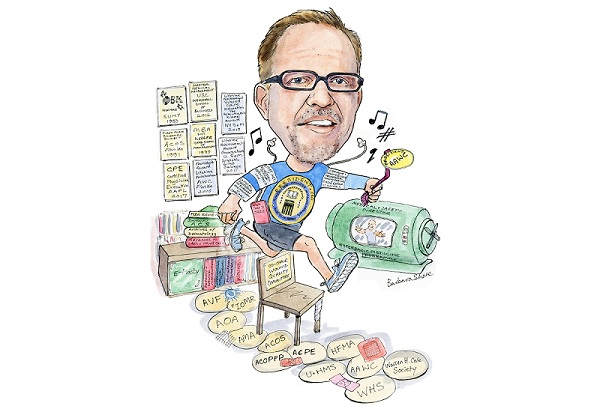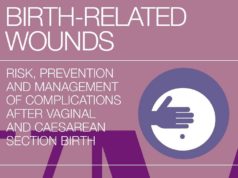
William Ennis is currently Catherine and Francis Burzik professor of Wound Healing and Tissue Repair, and chief of Wound Healing Section, University of Illinois, Chicago, USA. With his 25 years of experience practising wound care, Ennis speaks about what led him to the wound field, how it is changing with the increasing application of new technologies, and the importance of new vascular guidelines.
What led you to a career in medicine and why did you decide to specialise in wound healing and repair?
I had every intention of doing biological research when I went to college. While in my senior year, I was lucky to get a position doing research at Brookhaven National Lab in New York and my director, an MD/PhD, encouraged me to get a medical degree so that I could do both basic and clinical research. During the second year of medical school I became extremely fascinated with anatomy. I spent hours doing dissections and simulating surgical procedures with my anatomy teacher, who himself had been a practising surgeon. That experience convinced me to do general and vascular surgery training. My interest and exposure to wound care grew from the vascular surgery department in Chicago.
Who were some of your key mentors and influences as you trained to become a physician?
Walter Reagan was my first surgical mentor, as his expertise in the operating room and command of cellular physiology truly inspired me to become an academic. Dr’s Sloan and McBrayer allowed me to pursue wound care during and after my vascular fellowship. I established a wound care clinic in my first year of vascular surgery practice and with Dr Meneses, my collaborating PhD for 20 years, embarked on creating both a clinical and research approach to wound care that I still follow today.
In what ways has wound care and healing space changed during your time in medicine?
When I first started, no one had a clue what a wound clinic was and there were only a few advanced dressings on the market to choose from. My surgical training allowed me to realise that the key to wound care is to maximise the medical condition of the patient, surgically prepare the wound bed, control the bacterial load and ensure adequate tissue perfusion. Those principles are just as important today despite the thousands of advanced wound care products that are on the market. Our biggest advancement has been the understanding of the wound healing process at the cellular and biochemical level. These research findings have driven product innovation and therapeutic options for today’s wound care provider.
What technologies are you watching closely, and how do you hope to see technological development impact wound care in the next few years?
In our field, advances in therapy have outpaced those in diagnostics. This is very different from most other specialties in medicine. Over the past few years, however, we are beginning to see diagnostic tools that measure cytokines in the wound fluid, tissue microcirculation status, oxygen levels and the biochemical composition of the wound tissue. Continued advances in these diagnostic tools will allow providers to more accurately identify the aetiology of the wound and to better target treatment options.
Do artificial intelligence and predictive analytics have the potential to majorly impact wound healing and repair?
I am a strong believer in big data and predictive analytics in medicine in general, and wound care specifically. One of the problems in wound care is that many individual practitioners do not see the volume of cases that allow for the development of internal expertise. Pattern recognition and machine learning algorithms can provide adjunctive knowledge for the provider and in a way democratise wound expertise to a broader clinician base.
Do you think that there should be more of an emphasis on new interventional wound healing techniques, as well as developing advanced dressings?
Yes, I think we have plateaued in dressing technology and now require more advanced techniques to help the wave of wound care patients that are descending on the healthcare system due to an aging population and epidemics in diabetes and obesity. Futuristic techniques such as 3D-printing of skin is an example of a breakthrough technology that could revolutionise how we care for wounds.
Is there a recent paper on an aspect of wound healing that stands out to you, and why?
I think that the level of scientific rigour in wound care publications over the past few years is what really stands out to me as opposed to a specific paper. The field had to mature from using case studies and anecdotes into a credible field of medicine. The healthcare system now demands this approach.
What progress has the American College of Wound Healing and Tissue Repair (ACWHTR) made during your tenure as president and CEO?
The mission of the organisation is to create a formal specialty status for wound care. Our creation of several wound care fellowships and the application to the American Council for Graduate Medical Education (ACGME) for accreditation of this training have been the biggest highlights thus far.
Has there been any significant movement on securing fellowship status for wound care specialists?
As we await a final ACGME decision on the formal fellowship programmes, we are also attempting to create a hybrid fellowship that would include both face-to-face and virtual training so that mid-career physicians could advance their education without having to take time away from their careers. This is done all the time in nonclinical graduate education but would be disruptive in medicine. The ACWHTR is also leading this charge.
How important will the new vascular guidelines and classification system for wounds be?
I believe they are extremely important, not only so that we are speaking the same language, but so that we can better predict the likelihood of whether a specific wound will heal or not. The CX meeting and others like it play a pivotal role in ensuring that these guidelines are disseminated to the wound care community. For example, many wound care meetings have lectures on venous ulcers without any mention to this day of the CEAP classification. Meetings that ensure cross-pollination of guidelines, advances and enhance team-based clinical collaboration play an enormous role in improving wound care outcomes moving forward.
Are there any other wound healing initiatives you have encountered that are driving change?
Likely the biggest initiative that will impact wound care is that payers are calculating the total cost of care and we will likely have wound care bundles in the future. While this is a US-based phenomenon, it will force us to emphasise the provision of value-based outcomes in wound care, defined as improved outcomes for less cost.
What are some of the proudest moments of your career?
The day we graduated our first fellow from the University of Illinois at Chicago (UIC) along with the surgical residents stands out for me. I knew that this event marked the formal beginning of our field becoming a specialty. The other proud moment was receiving the Catherine and Francis Burzik endowed professorship in wound healing, the first of its kind in the USA, also at UIC.
Could you tell us about one of your most memorable wound cases?
I distinctly remember, early in my career, a 48-year-old diabetic with a motorcycle injury and exposed distal tibia. He refused a flap procedure which was the standard of care. We tried a new device, negative pressure wound therapy, which at the time was considered experimental, and we were gathering data for Medicare. The bone completely granulated over and we were able to place a skin graft and completely heal the patient. He and his wife named their child after the name of our subacute unit!
What are some of your hobbies and interests outside of medicine?
I was a musician throughout high school and college and played in many bands. I still love music and listen almost all day, every day. I also love to run, bike, swim and compete in triathlons.












